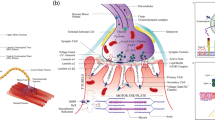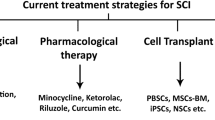Abstract
Myelin and lymphocyte protein (MAL) was identified as a tetraspan proteolipid that is highly expressed by oligodendrocytes and Schwann cells as a component of compact myelin. It has also been reported to be a tumour suppressor and induces apoptosis through the Fas pathway. However, its expression and function in spinal cord injury are still unclear, especially in gray matter. In this study, we performed a spinal cord contusion injury (SCI) model in adult rats and detected the dynamic changes of MAL expression in spinal cord. Western blot and immunohistochemistry analysis revealed that MAL was present in gray and white matter of normal spinal cord. It gradually increased, got a peak at 1 day, and then declined to basal levels after spinal cord injury. Double immunofluorescence staining showed that MAL immunoreactivity was found in neurons and oligodendrocytes. Interestingly, MAL expression was increased predominantly in neurons rather than oligodendrocytes. We also examined the expression profiles of active caspase-3, whose changes were correlated with the expression profiles of MAL. Moreover, co-localization of MAL with active caspase-3 was detected. In conclusion, this is the first description of MAL expression changes in gray matter after spinal cord injury. Our results prompted that MAL might participate in CNS pathophysiology after SCI.





Similar content being viewed by others
Abbreviations
- MAL:
-
Myelin and lymphocyte protein
- CNS:
-
Central nervous system
- PAGE:
-
Polyacrylamide gel electrophoresis
- ECL:
-
Enhanced chemiluminescence system
- BSA:
-
Bovine serum albumin
- DAB:
-
Diaminobenzidin
- NeuN:
-
Neuronal nuclei
- GAPDH:
-
Glyceraldehyde-3-phosphate dehydrogenase
- SCI:
-
Spinal cord injury
References
Ambrozaitis KV, Kontautas E, Spakauskas B, Vaitkaitis D (2006) Pathophysiology of acute spinal cord injury. Medicina (Kaunas) 42:255–261
Barca O, Carneiro C, Costoya JA, Senaris RM, Arce VM (2010) Resistance of neonatal primary astrocytes against Fas-induced apoptosis depends on silencing of caspase 8. Neurosci Lett 479:206–210
Basso DM, Beattie MS, Bresnahan JC (1995) A sensitive and reliable locomotor rating scale for open field testing in rats. J Neurotrauma 12:1–21
Boatright KM, Salvesen GS (2003) Mechanisms of caspase activation. Curr Opin Cell Biol 15:725–731
Bouchard VJ, Rouleau M, Poirier GG (2003) PARP-1, a determinant of cell survival in response to DNA damage. Exp Hematol 31:446–454
Buffart TE, Overmeer RM, Steenbergen RD, Tijssen M, van Grieken NC, Snijders PJ, Grabsch HI, van de Velde CJ, Carvalho B, Meijer GA (2008) MAL promoter hypermethylation as a novel prognostic marker in gastric cancer. Br J Cancer 99:1802–1807
Cao W, Zhang ZY, Xu Q, Sun Q, Yan M, Zhang J, Zhang P, Han ZG, Chen WT (2010) Epigenetic silencing of MAL, a putative tumor suppressor gene, can contribute to human epithelium cell carcinoma. Mol Cancer 9:296
Carmosino M, Rizzo F, Procino G, Basco D, Valenti G, Forbush B, Schaeren-Wiemers N, Caplan MJ, Svelto M (2010) MAL/VIP17, a new player in the regulation of NKCC2 in the kidney. Mol Biol Cell 21:3985–3997
Ceruti S, Villa G, Genovese T, Mazzon E, Longhi R, Rosa P, Bramanti P, Cuzzocrea S, Abbracchio MP (2009) The P2Y-like receptor GPR17 as a sensor of damage and a new potential target in spinal cord injury. Brain 132:2206–2218
Chen KB, Uchida K, Nakajima H, Yayama T, Hirai T, Watanabe S, Guerrero AR, Kobayashi S, Ma WY, Liu SY, Baba H (2011) Tumor necrosis factor-alpha antagonist reduces apoptosis of neurons and oligodendroglia in rat spinal cord injury. Spine (Phila Pa 1976) 36:1350–1358
Frank M (2000) MAL, a proteolipid in glycosphingolipid enriched domains: functional implications in myelin and beyond. Prog Neurobiol 60:531–544
Frank M, Schaeren-Wiemers N, Schneider R, Schwab ME (1999) Developmental expression pattern of the myelin proteolipid MAL indicates different functions of MAL for immature Schwann cells and in a late step of CNS myelinogenesis. J Neurochem 73:587–597
Frank M, Atanasoski S, Sancho S, Magyar JP, Rulicke T, Schwab ME, Suter U (2000) Progressive segregation of unmyelinated axons in peripheral nerves, myelin alterations in the CNS, and cyst formation in the kidneys of myelin and lymphocyte protein-overexpressing mice. J Neurochem 75:1927–1939
Gruner JA (1992) A monitored contusion model of spinal cord injury in the rat. J Neurotrauma 9:123–126 (discussion 126–128)
Horne HN, Lee PS, Murphy SK, Alonso MA, Olson JA Jr, Marks JR (2009) Inactivation of the MAL gene in breast cancer is a common event that predicts benefit from adjuvant chemotherapy. Mol Cancer Res 7:199–209
Huan W, Wu X, Zhang S, Zhao Y, Xu H, Wang N, Li H, Chen H, Wei H, Wang Y (2012) Spatiotemporal patterns and essential role of TNF receptor-associated factor 5 expression after rat spinal cord Injury. J Mol Histol 43:527–533
Jana A, Hogan EL, Pahan K (2009) Ceramide and neurodegeneration: susceptibility of neurons and oligodendrocytes to cell damage and death. J Neurol Sci 278:5–15
Kaufmann T, Strasser A, Jost PJ (2012) Fas death receptor signalling: roles of Bid and XIAP. Cell Death Differ 19:42–50
Khalatbary AR, Zarrinjoei GR (2012) Anti-inflammatory effect of oleuropein in experimental rat spinal cord trauma. Iran Red Crescent Med J 14:229–234
Krupinski J, Ferrer I, Barrachina M, Secades JJ, Mercadal J, Lozano R (2002) CDP-choline reduces pro-caspase and cleaved caspase-3 expression, nuclear DNA fragmentation, and specific PARP-cleaved products of caspase activation following middle cerebral artery occlusion in the rat. Neuropharmacology 42:846–854
Kwon KB, Yoo SJ, Ryu DG, Yang JY, Rho HW, Kim JS, Park JW, Kim HR, Park BH (2002) Induction of apoptosis by diallyl disulfide through activation of caspase-3 in human leukemia HL-60 cells. Biochem Pharmacol 63:41–47
Li X, Zhang XL, Shen G, Tang GH (2012) Effects of tensile forces on serum deprivation-induced osteoblast apoptosis: expression analysis of caspases, Bcl-2, and Bax. Chin Med J (Engl) 125:2568–2573
Liou AK, Clark RS, Henshall DC, Yin XM, Chen J (2003) To die or not to die for neurons in ischemia, traumatic brain injury and epilepsy: a review on the stress-activated signaling pathways and apoptotic pathways. Prog Neurobiol 69:103–142
Mathiasen IS, Jaattela M (2002) Triggering caspase-independent cell death to combat cancer. Trends Mol Med 8:212–220
Mimori K, Shiraishi T, Mashino K, Sonoda H, Yamashita K, Yoshinaga K, Masuda T, Utsunomiya T, Alonso MA, Inoue H, Mori M (2003) MAL gene expression in esophageal cancer suppresses motility, invasion and tumorigenicity and enhances apoptosis through the Fas pathway. Oncogene 22:3463–3471
Overmeer RM, Henken FE, Bierkens M, Wilting SM, Timmerman I, Meijer CJ, Snijders PJ, Steenbergen RD (2009) Repression of MAL tumour suppressor activity by promoter methylation during cervical carcinogenesis. J Pathol 219:327–336
Puertollano R, Li S, Lisanti MP, Alonso MA (1997) Recombinant expression of the MAL proteolipid, a component of glycolipid-enriched membrane microdomains, induces the formation of vesicular structures in insect cells. J Biol Chem 272:18311–18315
Putcha GV, Harris CA, Moulder KL, Easton RM, Thompson CB, Johnson EM Jr (2002) Intrinsic and extrinsic pathway signaling during neuronal apoptosis: lessons from the analysis of mutant mice. J Cell Biol 157:441–453
Saadoun S, Bell BA, Verkman AS, Papadopoulos MC (2008) Greatly improved neurological outcome after spinal cord compression injury in AQP4-deficient mice. Brain 131:1087–1098
Schaeren-Wiemers N, Bonnet A, Erb M, Erne B, Bartsch U, Kern F, Mantei N, Sherman D, Suter U (2004) The raft-associated protein MAL is required for maintenance of proper axon–glia interactions in the central nervous system. J Cell Biol 166:731–742
Sharifi AM, Eslami H, Larijani B, Davoodi J (2009) Involvement of caspase-8, -9, and -3 in high glucose-induced apoptosis in PC12 cells. Neurosci Lett 459:47–51
Shen A, Liu Y, Zhao J, Qin J, Shi S, Chen M, Gao S, Xiao F, Lu Q, Cheng C (2008) Temporal-spatial expressions of p27kip1 and its phosphorylation on Serine-10 after acute spinal cord injury in adult rat: Implications for post-traumatic glial proliferation. Neurochem Int 52:1266–1275
Song MS, Seo HS, Yang M, Kim JS, Kim SH, Kim JC, Wang H, Sim KB, Kim H, Shin T, Moon C (2009) Activation of Ca2 +/calmodulin-dependent protein kinase II alpha in the spinal cords of rats with clip compression injury. Brain Res 1271:114–120
Strasser A, Jost PJ, Nagata S (2009) The many roles of FAS receptor signaling in the immune system. Immunity 30:180–192
Torres BB, Caldeira FM, Gomes MG, Serakides R, de Marco Viott A, Bertagnolli AC, Fukushima FB, de Oliveira KM, Gomes MV, de Melo EG (2010) Effects of dantrolene on apoptosis and immunohistochemical expression of NeuN in the spinal cord after traumatic injury in rats. Int J Exp Pathol 91:530–536
van Wijk SJ, Hageman GJ (2005) Poly(ADP-ribose) polymerase-1 mediated caspase-independent cell death after ischemia/reperfusion. Free Radic Biol Med 39:81–90
Wang ZB, Liu YQ, Cui YF (2005) Pathways to caspase activation. Cell Biol Int 29:489–496
Wu G, Cao J, Peng C, Yang H, Cui Z, Zhao J, Wu Q, Han J, Li H, Gu X, Zhang F (2011) Temporal and spatial expression of cyclin H in rat spinal cord injury. NeuroMol Med 13:187–196
Xu D, Cui S, Sun Y, Bao G, Li W, Liu W, Zhu X, Fan J, Wang Y, Cui Z (2011) Overexpression of glucose-regulated protein 94 after spinal cord injury in rats. J Neurol Sci 309:141–147
Yano H, Fukuda K, Haramaki M, Momosaki S, Ogasawara S, Higaki K, Kojiro M (1996) Expression of Fas and anti-Fas-mediated apoptosis in human hepatocellular carcinoma cell lines. J Hepatol 25:454–464
Yin X, Yin Y, Cao FL, Chen YF, Peng Y, Hou WG, Sun SK, Luo ZJ (2012) Tanshinone IIA attenuates the inflammatory response and apoptosis after traumatic injury of the spinal cord in adult rats. PLoS ONE 7:e38381
Yu X, Zhong Y, Zhu Z, Wu T, Shen A, Huang Y (2012) Increased expression of nitric oxide synthase interacting protein (NOSIP) following traumatic spinal cord injury in rats. J Mol Histol 43(6):661–668
Zhang S, Huan W, Wei H, Shi J, Fan J, Zhao J, Shen A, Teng H (2012) FOXO3a/p27(kip1) expression and essential role after acute spinal cord injury in adult rat. J Cell Biochem. doi:10.1002/jcb.24371
Acknowledgments
This work was supported by the National Natural Science Foundation of China (No. 81271367).
Author information
Authors and Affiliations
Corresponding author
Additional information
Jinlong Zhang and Zhiming Cui are contributed equally to this work.
Rights and permissions
About this article
Cite this article
Zhang, J., Cui, Z., Shen, A. et al. Upregulation of myelin and lymphocyte protein (MAL) after traumatic spinal cord injury in rats. J Mol Hist 44, 125–134 (2013). https://doi.org/10.1007/s10735-012-9469-0
Received:
Accepted:
Published:
Issue Date:
DOI: https://doi.org/10.1007/s10735-012-9469-0




